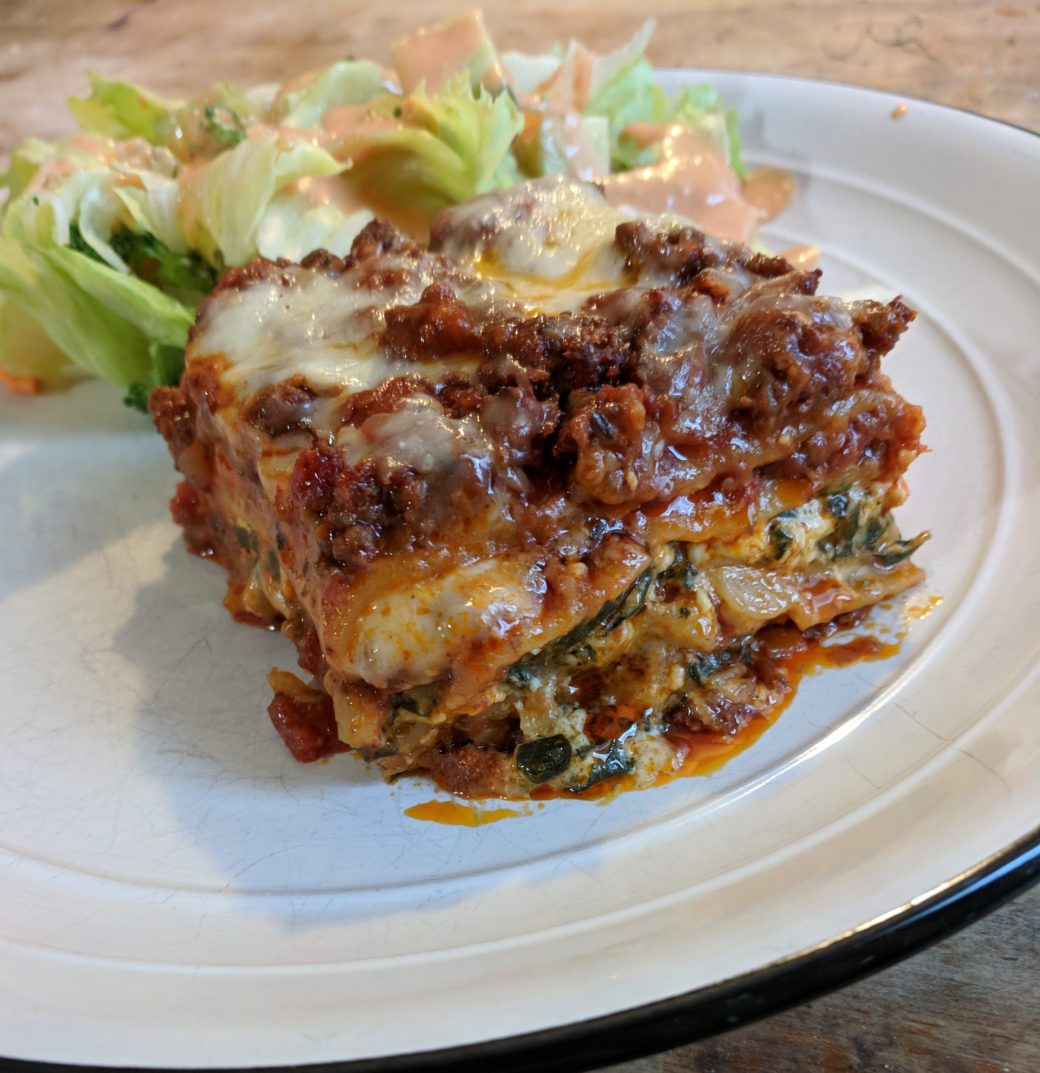Loved by people and fat orange cats alike, lasagna is one of those dishes that everyone makes. Everyone has there own version, myself included. But like everything, there good and bad versions. So, today I want to take the opportunity to talk about how an okay lasagna can be made into a great one. Today is all about…
Everything I know about lasagna
Sauce
In my opinion, the most important piece of the lasagna pie is the sauce. As the sauce is where the biggest part of the flavour comes from in a lasagna it better be damn good. Now, it doesn’t necessarily need to be a meat sauce or even a tomato sauce. There are plenty of really good white sauce based lasagnas out there. So keep that in mind.
I want to break down the three main sauce options.
Meat Sauce
Probably the most common sauce for lasagna is meat sauce. A classic bolognese sauce with just a touch of heat, well-balanced acidity and sweetness, and ready to rumble. It doesn’t get much better than that. The problem is that with sauces of all stripes people tend to overdo it with flavours and ingredients.
Having a twenty ingredient sauce is all well and good, but that’s twenty things that can go wrong. Twenty flavours that can clash. More often than not, the best cooking comes from restraint. The best chef’s in the world know it’s not so much about what you add to a recipe, it’s what you don’t add that matters.
For me, the best meat sauces are the simplest ones. Ground meat (beef and pork), maybe a little red wine, a touch of garlic, a few chilli flakes, some stock, tomato, onion, salt and pepper, maybe a touch of sugar, and the tiniest little pinch of oregano. That’s it. That’s all you need.
But the key is time. It’s giving the meat time to brown properly so you get that deep rich meat flavour. Giving the onions time to caramelize a bit to add sweetness to the sauce. It’s reducing the wine and the stock to concentrate their flavours. And, it’s about giving the sauce time to simmer so all the flavours come together and the sauce gets the right consistency. It’s all about time.
Tomato Sauce
The principles of meat sauce hold true for tomato sauce as well. It’s about time and restraint. For a more in-depth look at tomato sauce check out this post I wrote a few days ago all about how to make tomato sauce.
White Sauce
White sauce or bechamel along with tomato sauce make up two of the five traditional mother sauces. Essentially, the base of French and European cooking. Knowing how to make this sauce properly allows you to make hundreds and hundreds of dishes. In fact, you probably already know how to make this and might not even know it. Don’t believe me?
White lasagna, mac and cheese, most chowders, some cream soups, cheese sauces, moussaka, mornay sauce, white sauce for salmon, and many many others things are made with bechamel.
So, how do you make a really good bechamel? Well, just like meat sauce, and tomato sauce, with restraint and time.
A really good bechamel sauce has around eight ingredients in it. Those are milk, flour, butter, onion, bay leaf, nutmeg, salt and pepper. There may also be a touch, just a drop of lemon juice to brighten it. The way it’s made is by first combining the flour and butter in a pot over medium heat to make a roux. To this, the milk (whole milk) is added along with the onion, bay leaf, and a pinch of nutmeg.
These ingredients are all cooked together over a medium-low heat for twenty minutes or so, being whisked pretty regularly. Essentially, you want to cook the sauce until you can’t taste flour anymore and it has the desired consistency. You then season the sauce to taste with salt, pepper, and lemon juice. Finally, you strain the sauce to remove all the onion, and bay leaf.
That is how you make a really good bechamel.
This sauce generally is used for seafood lasagna or often for a vegetarian like a butternut squash. You could also make a very delicious chicken and bechamel lasagna.
If you have never had a lasagna made with a white sauce before, I highly recommend you try it.
Pasta
It should go without saying that when making a pasta dish that pasta should be good. This is especially true when it comes to lasagna. The better quality pasta you use the more structure your lasagna will have.
In the supermarket today your options are almost limitless when it comes to brands and types of pasta. You can get traditionally dried lasagna noodles that you have to boil first. You can get noodles that go in the lasagna dried and come out perfectly cooked, you can even get fresh pasta sheets in more grocery stores that can be used to make lasagna. Of course, you can always make your own pasta too.
Really, the big thing with pasta is not cheap out on it. Even the most expensive pasta is still pretty cheap so spend the extra dollar and pay for quality.
Experiment with a few different types of pasta and brands and see what you like best. At the end of the day, you are the one eating the lasagna so pick a pasta you like.
Cheese
There are many different kinds of cheese that you can put in a lasagna. From parmesan and mozza to ricotta and provolone, even cottage cheese the options are limitless. It will likely come as no surprise that I prefer simplicity. I generally use both parmesan and mozzarella, but I also love ricotta and provolone as well. It’s up to you. What I will say, is just like the pasta, don’t cheap out on the cheese.
That shaker of sawdust-like parmesan is not going to give you the best flavour. I know a lot of people love that stuff but it is the bane of my existence. Spring for a wedge of real Parmigiano Reggiano and really good mozza. It is absolutely worth it.
Like everyone else, I like to put cheese between each layer. I think that goes without saying. I also like to sprinkle a little bit of dried oregano between each layer. Not too much, just a pinch will do it.
Center
A lot of people out there make lasagna with consistent layers, which is fine. I prefer to make the center layer different than the rest. Sometimes I will put a layer of either ricotta or cottage cheese mixed with spinach and egg or just the cheese itself. Sometimes I like a layer of bechamel. Maybe even a layer of zucchini or eggplant.
This center layer gives a bit of a break from the same old flavours in the other layers. It also adds a nice visual touch once the lasagna is cut.
Conclusion
Lasagna is a delicious pasta dish. Even bad lasagna is still pretty good. Hopefully, the information in the post will help you make an even better lasagna than you are used to.
If you think I missed something or, if you have a tip of your own, I would love to hear about it in the comments.


If I only have frozen spinach on hand…..How would suggest I add it to the lasagne? I’m thinking I should get all the water out of it & add the egg; mix well & spoon on center layer.
Hello Cathy, that’s exactly right. Defrost the spinach, squeeze out all the liquid, mix it with egg and cheese and then layer it into the lasagna.